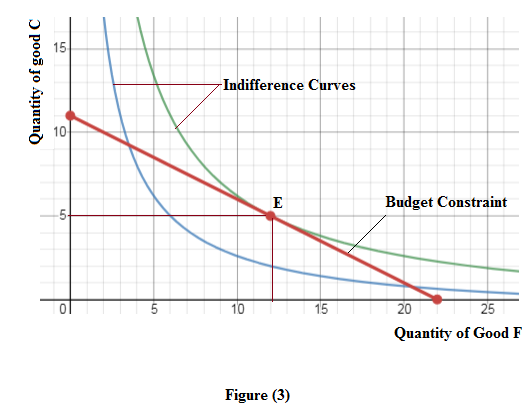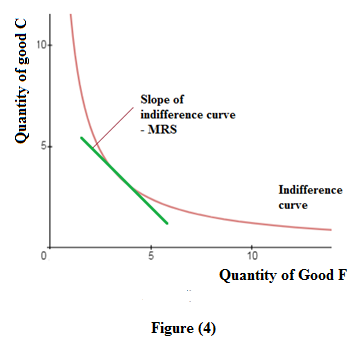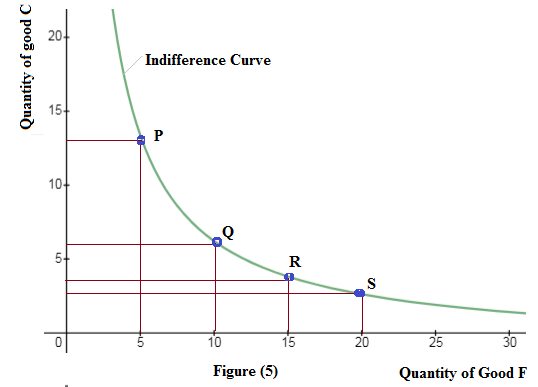
(a)
Units of clothing the consumer is consuming.
Explanation of Solution
The consumer prefers food (F) and clothing (C). The per-unit price of 'F' and 'C' is equal to $1 and $2, respectively. The income of the consumer is equal to $22.
Budget constraint depicts different bundles of goods and services that the consumers can purchase at a given level of market prices and their income.
Mathematically, it is expressed as follows:
Here,
'F' represents units of food
'PF'represents price of food ($1)
'C' represents units of clothing
'Pc'represents price of clothing ($2)
'I' represent consumer's income ($22)
Thus, the budget constraint of the consumer is given as follows:
It is given that consumer is consuming 8 units of F. Plug the given value of F equal to 8 in (1) to get the value of C.
Thus, the consumer is consuming 7 units of Clothing.
(b)
To graph the budget line and plot the current consumption of both goods.
Explanation of Solution
Figure (1) below depicts the graph of the consumer's budget constraint 'BC'. Here, X-axis measures the quantity of good 'F' and the Y-axis measures the quantity of good 'C.'

Point A on the budget line BC depicts the current consumption basket of the consumer.
(c)
To graph indifference curves corresponding to utility =36 and utility =72.
Explanation of Solution
The utility function of the consumer is given as follows:
The figure (2) below depicts the graph of indifference curves corresponding to U=36 andU =72. Here, X-axis measures the quantity of good F and the Y-axis measures the quantity of good C.

The figure (2) shows that the indifference curves are in toward the origin.
(d)
To graphically show the Utility maximizing choice of the goods.
Explanation of Solution
At the optimal level of consumption, the slope of the indifference curve is equal to the slope of the budget constraint. Graphically, the point at which the budget line is tangent to the indifference curve gives the optimal level of consumption.
The figure (3) below plots the budget constraint along with the indifference curves of the consumer.

At point E, budget constraint is tangent to indifference curve. Thus, utility maximizing choice of F and C is equal to 12 units and 5 units respectively.
(e)
To find the Utility maximizing choice of the goods using algebra.
Explanation of Solution
The rate at which consumer is willing to sacrifice some units good F to get an additional unit of good C is known as the marginal rate of substitution (MRS).
It measures the slope of the indifference curve.
The ratio of the price of good F to the price of good C measures slope of the budget constraint.
At the optimum level of consumption, the slope of the indifference curve is equal to the slope of the budget constraint. Mathematically, it is expressed as follows:
Also, marginal utilities of the two goods are given as follows:
Plug the given expressions of the marginal utilities and the values of the prices in (2) as follows:
Put (3) in (1).
Plug value of C equal to 5 in (3).
Thus, utility-maximizing choice of F and C is equal to 12 units and 5 units respectively.
(f)
The marginal rate of substitution of F for C when the utility is maximized.
Explanation of Solution
Mathematically, the marginal rate of substitution of F for Cis expressed as the ratio of
Graphically, marginal rate of substitution of F for Cis expressed as slope of indifference curve of the consumer, as shown in figure (4) below:

(g)
Whether the consumer has a diminishing marginal rate of substitution of F for C.
Explanation of Solution
According to the law of diminishing marginal rate of substitution, the consumer is willing to sacrifice less and fewer units of good C to get an additional unit of good F.
According to figure (5), consumer switches from point Q to point R level of consumption and from point R to point S level of consumption.
Here, the quantity of good F increases by one unit, but the quantity of good C sacrificed decreases.
Thus, it is concluded that the consumer has a diminishing marginal rate of substitution of F for C.

Want to see more full solutions like this?
Chapter 4 Solutions
EBK MICROECONOMICS



 Economics (MindTap Course List)EconomicsISBN:9781337617383Author:Roger A. ArnoldPublisher:Cengage Learning
Economics (MindTap Course List)EconomicsISBN:9781337617383Author:Roger A. ArnoldPublisher:Cengage Learning





